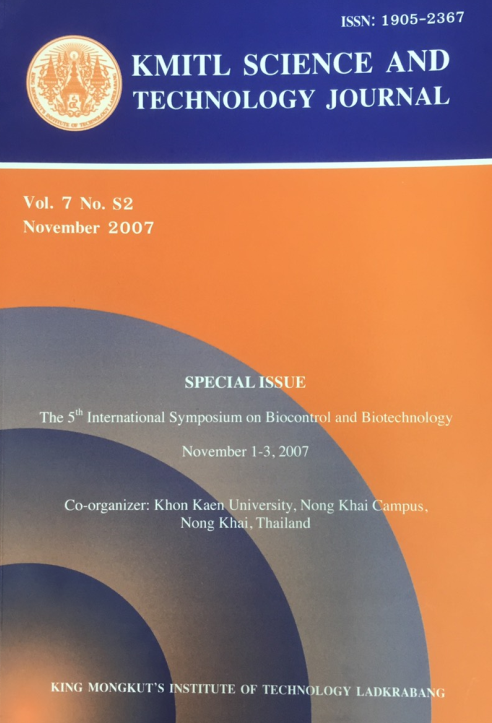BIOCONTROL OF Penicillium chrysogenum USING NUTMEG OIL AND TURMERIC OIL
Main Article Content
Abstract
Antifungal activities of nutmeg oil and turmeric oil against Penicillium chrysogenum screening from rubberwood kitchenette surface were investigated. The broth dilution method was employed to determine the minimal inhibitory concentration (MIC) and minimal fungicidal concentration (MFC) using the concentration of essential oils between 10-250 µL/mL. Inhibitory effects of the essential oils against mould on rubberwood were also examined by means of the dip treatment. It was found that the MIC and MFC values for each treatment were identical for all conditions examined. The MIC and MFC of nutmeg oil and turmeric oil against Penicillium chrysogenum were 100 µL/mL and 200 µL/mL, respcetively. In addition, nutmeg oil and tumeric oil at MIC and MFC provided a protection from mold growth on rubberwood for at least 8 weeks at the storage condition of 30°C with 100%RH.
Keywords: biocontrol, Penicillium chrysogenum, nutmeg oil, turmeric oil
Corresponding author: E-mail: nnarumol@wu.ac.th
Article Details
Copyright Transfer Statement
The copyright of this article is transferred to Current Applied Science and Technology journal with effect if and when the article is accepted for publication. The copyright transfer covers the exclusive right to reproduce and distribute the article, including reprints, translations, photographic reproductions, electronic form (offline, online) or any other reproductions of similar nature.
The author warrants that this contribution is original and that he/she has full power to make this grant. The author signs for and accepts responsibility for releasing this material on behalf of any and all co-authors.
Here is the link for download: Copyright transfer form.pdf
References
[2] Gnanaharan, R. and Dhamodaran, T.K. 1993 A Pilot Plant Investigation of Boron Treatment of Rubberwood: Arriving at an Economical Treatment Schedule. Holz Roh Werkst, 51, 279-283.
[3] Emmert, E.A. B. and Handelsman, J. 1999 Biocontrol of Plant Disease: a (Gram-) Positive Perspective, FEMS Microbiology Letters, 171(1), 1-9.
[4] Yang, V.W. and Clausen, C.A. 2007 Antifungal Effect of Essential Oils on Southern Yellow Pine, International Biodeterioration & Biodegradation, 59, 302-306.
[5] Burt, S. 2004 Essential Oils: Their Antibacterial Properties and Potential Applications in Foods- A Review. International Journal of Food Microbiology, 94, 223-253.
[6] Matan, N and Matan, N. 2008 Antifungal Activities of Anise Oil, Lime Oil and Tangerine Oil Against Molds on Rubberwood (Hevea brasiliensis), International Biodeterioration & Biodegradation, 62(1), 75-78.
[7] Matan, N. 2007 Growth Inhibition of Aspergillus niger by Cinnamaldehyde and Eugenol, Walailak Journal of Science and Technology, 4(1), 41-51.
[8] Matan, N., Rimkeeree, H. Mawson, A.J., Chompreeda, P., Haruthaithanasan, V. and Parker, M. 2006 Antimicrobial Activity of Cinnamon and Clove Oils under Modified Atmosphere Conditions, International Journal of Food Microbiology, 107(2), 180-185.
[9] Matan, N. 2006 Utilization of Cinnamon Oil and Clove Oil as Anitifungi in Active Packaging for IMF Products. Kasetsart University, Bangkok, pp. 217.
[10] Rasooli, I., Rezaei, M.B. and Allameh, A. 2006 Growth Inhibition and Morphological Alterations of Aspergillus niger by Essential Oils from Thymus eriocalyx and Thymus x- porlock, Food Control, 17, 359-364.
[11] American Society for Testing and Material. 1998 Standard Test Method for Fungicides for Controlling Stain and Mold on Unseasoned Lumber (laboratory method). ASTM Standard D4445-91, Vol. 11.01, West Conshohocken, pp. 497-500.
[12] Valero, M. and Francés, E. 2006 Synergistic Bactericidal Effect of Carvacrol, Cinnamaldehyde or Thymol and Refrigeration to Inhibit Bacillus cereus in Carrot Broth. Food Microbiology, 23(1), 68-73.
[13] Tainter, D.R. and Grenis, A.T. 2001 Spices and Seasonings (2nd ed.). John Wiley and Sons, New York.
[14] Jayaprakasha, G.K., Jagan Mohan Rao, L. and Sakariah, K.K. 2005 Chemistry and Biological Activities of C. longa, Trends in food Science and Technology, 16(2), 533-548.


